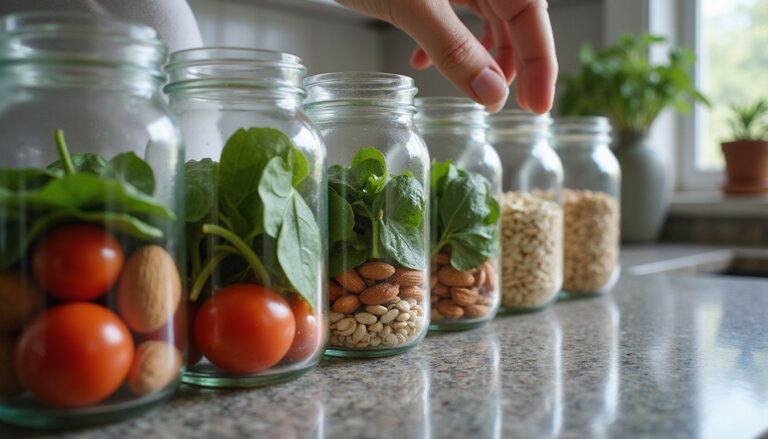Top Fat-Burning Foods For Weight Loss: Lose Weight With These Powerful Ingredients
Our Nutrition Assistant AI Suite will transform your body. You will lose fat, get toned, and build muscle. Gain confidence and optimal health.
Losing extra weight can feel confusing with so many diet choices. The good news, certain fat-burning foods make it easier to burn more calories and shrink stubborn belly fat.
This guide highlights the best fat-fighting foods, why they work, and how to use them. You will see quick tips, simple science, and practical ideas you can start today.
Key Takeaways
- High-protein foods such as Greek yogurt and eggs raise calorie burn through the thermic effect of food and help you feel full.
- Fiber-rich picks like oatmeal, lentils, pears, and apples slow digestion and steady blood sugar, which reduces hunger between meals.
- Green tea and coffee can increase metabolism by about 3 to 11 percent, thanks to catechins in tea and caffeine in coffee.
- Healthy fats from salmon, mackerel, avocados, and MCT oil support fat burning, heart health, and steady energy with fewer cravings.
- Low-calorie, high-water foods, including watermelon and cucumber, fill you up on fewer calories and support healthy weight loss.

What Are Fat-Burning Foods and How Do They Help You Lose Weight?

Fat-burning foods contain nutrients that help your body use energy more effectively. When you build meals around these foods, weight loss becomes easier to manage.
What are fat-burning foods?
These are foods high in protein, fiber, or healthy fats. Protein and fiber take more energy to digest. This is called the thermic effect of food, a natural rise in calorie burning after meals.
Protein-rich choices such as eggs or Greek yogurt slightly increase metabolism because your body spends more calories digesting protein than carbohydrates or fat. Whole grains and vegetables rich in dietary fiber also keep you full longer, which helps you eat fewer calories.
Low-calorie fruits and vegetables, like apples and broccoli, have high water content. They help you feel satisfied on fewer calories. Fatty fish supply omega-3 fatty acids, which may support how the body uses fat for energy.
How do they aid weight loss?
Fat-burning foods make weight loss easier through three paths: they raise calorie burn, control hunger, and improve blood sugar control. Protein takes longer to digest, so meals with eggs or Greek yogurt keep you full and help limit snacking.
Oatmeal and lentils slow digestion and help stabilize blood sugar. That steadiness reduces cravings later. Spicy foods such as chili peppers contain capsaicin, a plant compound that can slightly increase energy use and fat oxidation, which means using fat for fuel.
High-water, high-fiber produce, including watermelon and broccoli, fills your plate for fewer calories. These habits support sustainable weight loss when paired with a healthy lifestyle.
High-Protein Foods That Help Burn Fat
Protein helps you burn fat and preserve muscle. It also keeps you full longer, which makes calorie control easier.
Why is Greek yogurt good for fat loss?
Greek yogurt is high in protein and usually low in fat and sugar. A 6-ounce serving of nonfat Greek yogurt has about 15 grams of protein with under 100 calories. Higher protein intake increases the thermic effect of food and supports fat loss during dieting.
Strained yogurt has less lactose and sugar than regular yogurt. That can help with weight loss and blood sugar control. It works well at breakfast, as a snack, or blended into smoothies with berries and nuts. Many people with type 2 diabetes also find Greek yogurt useful because it may reduce blood sugar spikes.
“Studies show that protein-rich foods like Greek yogurt promote weight loss and help preserve muscle during dieting.”
How do eggs support weight loss?
Eggs provide complete protein, which means they contain all essential amino acids. Eating eggs at breakfast can reduce hunger and help you manage calories for the rest of the day. In one study, participants who ate eggs in the morning consumed up to 400 fewer calories over 24 hours than those who had a bagel breakfast.
Your body also expends more energy digesting protein than carbohydrates or fat. This thermic effect supports fat burning and can nudge your metabolism higher. One large egg has around 70 calories and 6 grams of high-quality protein. Eggs may also raise HDL, the “good” cholesterol, in many people.
What lean meats burn fat effectively?
Chicken breast and turkey are classic lean meats. Both provide a lot of protein with little saturated fat, which helps you feel full while keeping calories in check. Skinless chicken breast offers about 31 grams of protein per 100 grams.
Fish such as salmon, cod, and tilapia add protein and important nutrients. Salmon includes omega-3 fats that may help reduce abdominal fat when combined with exercise. Lean beef cuts like sirloin or round steak provide iron and vitamin B12. Choose grilling or baking with spices like black pepper or chili powder instead of frying.
How does whey protein help burn fat?
Whey protein is a convenient, high-quality protein supplement. Higher protein intake can increase daily energy use and improve satiety. People who add whey protein to balanced meals often report fewer cravings and better portion control.
In research, those using whey sometimes lose more body fat than those who do not. It also helps maintain lean muscle during calorie deficits, especially if you exercise. Mix whey into water, milk, or oatmeal for a quick breakfast or recovery snack.
Fiber-Rich Foods That Promote Fat Loss
Fiber fills you up on fewer calories. It slows digestion, supports gut health, and helps control appetite throughout the day.
How does oatmeal help with fat loss?
Oatmeal provides soluble fiber, which forms a gel in your gut and slows digestion. That helps you feel full longer and makes it easier to eat fewer calories later. One cup of cooked oats has about 4 grams of fiber.
People who eat oats at breakfast often consume fewer calories at lunch. Oats also help steady blood sugar and prevent energy crashes. Use oatmeal as a base and add berries, nuts, or a pinch of cinnamon for flavor without lots of added sugar.
Why are lentils good for weight loss?
Lentils pack plant protein and fiber into a modest calorie budget. One cup of cooked lentils provides about 18 grams of protein and 15 grams of fiber for roughly 230 calories. That combination slows digestion and reduces the urge to snack.
They also have a low glycemic index, which helps you avoid rapid blood sugar spikes. Swap lentils for some pasta or rice to cut calories and stay satisfied. Lentil soup, salads, or hearty stews are simple ways to add them to your week.
How does broccoli aid fat burning?
Broccoli supports fat loss with high fiber and very few calories, about 31 per cup raw. It contains calcium, vitamin C, and sulforaphane, a plant compound studied for metabolic benefits. These nutrients may help your body use fat more effectively.
Roast or steam broccoli as a filling side. Toss florets into egg dishes or grain bowls to add volume and fiber while keeping calories low.
Can pears and apples help you lose weight?
Yes. Pears and apples offer water and fiber, which quiet hunger with minimal calories. A medium apple has about 95 calories and 4 grams of fiber. A medium pear provides around 100 calories and 5.5 grams of fiber.
Enjoy them as snacks or slice into salads, oatmeal, or yogurt. Their natural sweetness can replace desserts that rely on added sugar. Higher fruit intake is linked to lower obesity risk in population studies.
Foods That Boost Your Metabolism
Some foods work like a small spark for your engine, nudging calorie burn a bit higher.
How does green tea increase metabolism?
Green tea contains catechins, a type of antioxidant that supports fat oxidation. Studies suggest daily energy expenditure may rise by about 3 to 4 percent. Caffeine in green tea works with catechins to enhance the effect during rest and exercise.
Drinking one to two cups in the morning can help you feel more alert and steady. Many people notice gradual changes over several weeks when green tea becomes a daily habit.
Can coffee help you burn fat?
Yes. Caffeine stimulates the central nervous system and may raise metabolic rate by about 3 to 11 percent for a few hours. Having coffee before a workout can help your body use fat for fuel, which increases calories burned during the session.
A cup of black coffee can also briefly lower appetite. Keep added sugar and cream in check to avoid extra calories. If you are sensitive to caffeine, start small and avoid it late in the day.
What role do chili peppers play in fat loss?
Chili peppers provide capsaicin, the compound that makes them hot. Capsaicin can slightly increase energy use and may help reduce appetite, which supports calorie control. Some research shows adults who include capsaicin have lower snack cravings later in the day.
Try fresh chilies, crushed red pepper, or a mild hot sauce in omelets, bean bowls, or lean meats. Flavor goes up while calories stay low.
How does cinnamon support metabolism?
Cinnamon may improve insulin sensitivity, which helps your cells use sugar for energy instead of storing it as fat. Small daily amounts, about half a teaspoon, have been linked to better blood sugar in some studies.
Sprinkle cinnamon into oats, Greek yogurt, coffee, or on sliced apples. It adds sweetness without extra sugar and pairs well with high-fiber foods.
Healthy Fats That Help Burn Fat
Choosing the right fats can support fat loss, heart health, and steady energy throughout the day.
Benefits of fatty fish like salmon and mackerel
Fatty fish supply omega-3 fatty acids that may reduce inflammation and support metabolic health. They are also rich in protein, which keeps you full and helps protect muscle as you lose weight.
Salmon and mackerel provide vitamin D as well. Grilled salmon a couple of times per week is a simple habit that often cuts cravings and keeps energy stable.
What is MCT oil and how does it burn fat?
MCT oil contains medium-chain triglycerides, a type of fat your body absorbs quickly. The liver converts them into energy rather than storing them as body fat. Research suggests MCTs can increase daily calorie burn slightly.
Blend 1 teaspoon into coffee, smoothies, or yogurt and assess tolerance. Many people report better satiety and fewer sugary snack cravings after switching from standard oils.
How do avocados aid fat loss?
Avocados provide mostly monounsaturated fat and a good amount of fiber. This combination slows digestion and helps you feel full longer. One whole avocado contains roughly 13 grams of fiber.
Use mashed avocado instead of mayonnaise on sandwiches or stir into salads. These swaps add satisfaction without relying on highly processed spreads.
Hydrating and Low-Calorie Foods for Weight Loss
Foods with high water content help you feel full on fewer calories. They also support hydration, which can curb snack cravings that are actually thirst.
Why is watermelon good for weight loss?
Watermelon is about 92 percent water, so it is filling with very few calories. One cup has only 46 calories and contains lycopene, an antioxidant linked to heart health.
Keep a bowl of chilled watermelon in the fridge. It satisfies a sweet tooth while keeping calorie intake low.
How does grapefruit support fat burning?
Grapefruit is low in calories and high in fiber. Some small studies show people who eat half a grapefruit before meals lose more weight than those who do not. Naringenin, a plant compound in grapefruit, may support fat metabolism and healthier blood sugar.
Add slices to salads or enjoy as a snack. If you take prescription medicine, ask your healthcare professional first because grapefruit can interact with certain drugs.
Can cucumber help with weight loss?
Cucumber is very low in calories, about 16 per cup, and more than 95 percent water. That means you can eat a lot for very few calories. Proper hydration may also reduce bloating.
Add slices to salads, infuse in water with a splash of vinegar, or crunch on them instead of chips. Simple swaps like this reduce daily calories without leaving you hungry.
Why include celery in a fat-burning diet?
Celery is crisp, hydrating, and almost calorie free. One large stalk has about 10 calories and lots of water. It is useful for building volume into snacks and meals.
Some people refer to a “negative calorie” effect with celery. In reality, the effect is small, but the high water and fiber can support fullness. Pair celery sticks with hummus for a snack that satisfies.
Nutrient-Dense Foods to Help Curb Cravings
Nutrient-dense foods deliver more vitamins, minerals, fiber, and protein per calorie. They help steady energy and reduce cravings later in the day.
How does quinoa reduce hunger?
Quinoa offers both protein and fiber. One cup cooked provides about 8 grams of protein and 5 grams of fiber. That mix slows digestion and helps keep blood sugar stable, which reduces hunger.
Use quinoa in lunch salads or power bowls. Many people find it keeps afternoon snacking in check better than white rice or pasta.
What legumes help control appetite?
Chickpeas, black beans, lentils, pinto beans, and split peas deliver protein and soluble fiber. These nutrients slow digestion and increase fullness. Regular intake is linked to better appetite control and improved weight management in studies.
Try bean soups, chili, or roasted chickpeas. A simple habit like this can reduce cravings without adding many calories.
Are sweet potatoes good for fat loss?
Yes. Sweet potatoes are rich in fiber and have a low glycemic index, which means they release sugar into the bloodstream slowly. One medium sweet potato has about 4 grams of fiber and roughly 100 calories.
Bake or boil them instead of frying. Swap fries for baked sweet potato wedges to save calories while staying satisfied.
How do nuts and seeds support weight management?
Almonds, walnuts, cashews, chia, flaxseed, and pumpkin seeds are energy dense. Yet they increase fullness because they provide protein, fiber, and healthy fats. People who include small daily servings often have an easier time controlling hunger and maintaining a healthy body weight.
Keep portions to a small handful. Sprinkle seeds on oatmeal or yogurt to extend satiety into the next meal.
How to Add Fat-Burning Foods to Your Diet
Small tweaks add up. Build meals and snacks around protein, fiber, and water-rich produce to support your weight loss goals.
What are healthy snacks for weight loss?
Smart snacks prevent energy crashes and help you avoid overeating later. Choose options with protein, fiber, or healthy fats.
- Greek yogurt with blueberries for protein and antioxidants.
- Sliced apple or pear with a tablespoon of almond butter for fiber and healthy fats.
- Hummus with raw veggies like broccoli and celery for crunch and fiber.
- Hard-boiled eggs for easy protein between meals.
- A small handful of mixed nuts or seeds, watching portions.
- Oatmeal with berries for a warm, fiber-rich snack.
- Cottage cheese with sliced strawberries for protein and vitamin C.
- Edamame for plant-based protein and fiber.
- Air-popped popcorn for a low-calorie, high-fiber bite.
What are some fat-burning meal ideas?
Use ingredients that boost metabolism, add fiber, and provide lean protein. These combinations help you feel satisfied on fewer calories.
- Breakfast bowl with Greek yogurt, berries, chia seeds, and a sprinkle of cinnamon.
- Grilled salmon or mackerel with steamed broccoli and a side of quinoa.
- Stir-fry with lean chicken, lentils, bell peppers, and a light chili pepper sauce.
- Smoothie with whey protein, spinach, avocado, green tea, and half an apple.
- Mixed greens with cucumbers, celery, walnuts, and grilled turkey breast.
- Omelet with eggs, tomatoes, broccoli, onions, and a pinch of cinnamon.
- Baked sweet potato filled with black beans, salsa, and diced pears or apples.
- Roasted salmon with asparagus and a side of brown rice.
- Overnight oats with oatmeal, chia seeds, almond milk, diced pears, and cinnamon.
- Grilled chicken breast with sliced zucchini and a small portion of lentils.
- Grapefruit slices over cottage cheese or Greek yogurt for a light snack.
What Are the Benefits of Eating Fat-Burning Foods?
These foods do more than cut calories. They can nudge metabolism higher, reduce cravings, and support long-term health.
How do fat-burning foods increase metabolism?
Some foods raise energy use through thermogenesis, which is a mild rise in heat after eating. Spicy peppers may increase calorie burn slightly as your body cools itself. Green tea contains catechins that support fat oxidation. Protein also has a higher thermic effect than carbs or fat, so meals with more protein burn a few extra calories during digestion.
Research shows caffeinated coffee can boost metabolic rate by roughly 3 to 11 percent for several hours. Small boosts add up over time when matched with a consistent eating pattern and exercise.
Can these foods improve satiety and reduce cravings?
Yes. Protein and fiber slow digestion and help stabilize blood sugar, which reduces dips that trigger cravings. Greek yogurt, eggs, oatmeal, lentils, and nuts are strong choices for longer-lasting fullness.
Healthy fats from avocados and fatty fish also help. Many people find that adding a handful of almonds or a piece of fruit at key times cuts late-day snacking.
How do fat-burning foods benefit overall health?
These foods often deliver vitamins, minerals, antioxidants, and healthy fats. Whole grains and leafy greens support heart health. Omega-3 fish aid brain and joint health. Greek yogurt provides probiotics that support a healthy gut. Citrus fruits, including grapefruit, supply vitamin C for immune support while staying low in calories.
Better satiety also helps you build steadier eating habits, which supports lasting results and general health.
Conclusion
Choosing top fat-burning foods makes weight loss clearer and more doable. Green tea, chili peppers, and cinnamon can nudge calorie burn. High-protein and high-fiber foods help you feel full and keep cravings in check.
Healthy fats from salmon, avocados, and MCT oil support steady energy while you burn fat. Hydrating foods like watermelon and cucumber let you eat larger portions with fewer calories. Simple changes, such as adding protein to breakfast and building meals around fiber, move you toward your goals.
This article is informational and not medical advice. Speak with a healthcare professional for personal guidance, especially if you have a medical condition or take medications that interact with grapefruit or caffeine.
FAQs
1. Which foods are considered top fat-burning foods for weight loss?
Foods high in protein, fiber, and healthy fats help burn fat. Examples include lean meats, eggs, beans, nuts, and certain vegetables. Hot food takes longer to digest, which can increase calorie burn.
2. How does eating hot food help with weight loss?
Hot food takes longer to eat and digest. This slower process can help you feel full for a longer time and may boost your metabolism, leading to more calories burned.
3. Are there scientific studies supporting the use of fat-burning foods?
Yes, research shows that foods high in protein and fiber can increase satiety and calorie burn. Studies also suggest that spicy or hot food takes longer to digest, which may help with weight loss.
4. Can personal experience support the benefits of fat-burning foods?
Many people report feeling fuller and more satisfied after eating hot food that takes longer to digest. For example, after adding more spicy dishes and high-fiber foods to my meals, I noticed I stayed full longer and had fewer cravings.
Summary: Fat-burning foods like lean meats, beans, and hot food that takes longer to digest can help with weight loss. Scientific evidence and personal experience both support their benefits. Eating these foods may help you feel full and burn more calories.







